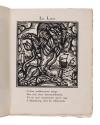Le Bestiaire, ou Cortège d'Orphée
Artist: Raoul Dufy (French, 1877-1953)
Author: Guillaume Apollinaire (French, 1880-1918)
Publisher: Deplanche, Éditeur d'art, Paris, 1911
Date: 1911
Dimensions:
slipcase: 14 3/16 x 11 in. (361 x 279mm)
book: 13 1/8 x 10 1/8 in. (333 x 257mm)
page (variable): 13 1/8 x 10 1/8 in. (333 x 257mm)
Medium: Original prints: 30 woodcuts and 5 woodcut ornaments
Text: letterpress
Paper: Imperial japan paper
Classification: Books
Credit Line: Purchased with funds from the Libbey Endowment, Gift of Edward Drummond Libbey
Object number: 1988.9
Label Text:Dufy's LA BESTIAIRE is one of the chief masterpieces of twentieth--century French poetry, graphic art, and book production. The text by the avant -garde poet Apollinaire (1880-1918) is about Orpheus, the musician in classic legend whose music charmed both beasts and men. The 30 succinct poems, each accompanied by a stinking illustration, feature an array of animals, including the tortoise, the horse, the goat, the snake, the lion, the camel, the elephant, the caterpillar, the octopus, and the peacock. Each image pulsates from Dufy's fanciful and vivid patterning.
Working in close collaboration with poet Guillaume Apollinaire after Picasso had abandoned the project, Raoul Dufy made 30 full-page woodcuts, one for each of Apollinaire’s poems. Typography and images were conceived together by poet and painter under the influence of Medieval and Renaissance bestiaries (illustrated collections, often moralizing, of both real and mythical animals) and more recent popular illustrated manuals of natural history. The contrasting velvety blacks and radiant whites combine with the intricate arabesques and decorative patterning to create seemingly traditional yet sophisticated and witty designs. Apollinaire’s poem on the page displayed was translated by poet X.J. Kennedy:
Squirting his ink to the sky,
Sucking his lovers’ blood, Like Benson’s etching of a sandpiper nearby, his depiction of a lone Greater Yellowlegs shorebird has a spareness and use of empty space that recalls Japanese images.
Finding the taste of it good,
This inhuman monster is I.
Though this book contains a collection of poem by French modernist poet Guillaume Apollinaire, it takes the medieval bestiary as its point of departure. Bestiaries were a primitive form of natural history book, which contained desc
riptions of animals and birds (some of them mythical) along with ore and legend associated with them. In his boldly designed images, artist Raoul Dufy was inspired by the medieval woodcut illustrations that accompanied the text in a bestiary. Below is a translation of Apollinaire's poem about the owl:
The Owl
My sad heart is a hoot owl nailed,
Torn loose and then again impaled.
Its blood and ardor end their days.
All those who love me, those I praise.
Le Bestiaire is one of the chief masterpieces of 20th-century French poetry, graphic art, and book production. Working in close collaboration with avant-garde poet Guillaume Apollinaire after Picasso had abandoned the project, Raoul Dufy made 30 full-page woodcuts, one for each of Apollinaire’s poems. Typography and images were conceived together by poet and painter under the influence of Medieval and Renaissance bestiaries (illustrated collections of both real and mythical animals, often with a moral lesson) and more recent popular illustrated volumes of natural history.
Inspired by Medieval woodcuts and the current interest in folk and peasant art, Dufy’s woodcuts for Le Bestiaire proved so dynamic that revolutionary fashion designer Paul Poiret hired Dufy to produce fabric designs based on the prints.
Working in close collaboration with poet Guillaume Apollinaire after Picasso had abandoned the project, Raoul Dufy made 30 full-page woodcuts, one for each of Apollinaire’s poems. Typography and images were conceived together by poet and painter under the influence of Medieval and Renaissance bestiaries (illustrated collections, often moralizing, of both real and mythical animals) and more recent popular illustrated manuals of natural history. The contrasting velvety blacks and radiant whites combine with the intricate arabesques and decorative patterning to create seemingly traditional yet sophisticated and witty designs. Apollinaire’s poem on the page displayed was translated by poet X.J. Kennedy:
Squirting his ink to the sky,
Sucking his lovers’ blood, Like Benson’s etching of a sandpiper nearby, his depiction of a lone Greater Yellowlegs shorebird has a spareness and use of empty space that recalls Japanese images.
Finding the taste of it good,
This inhuman monster is I.
Though this book contains a collection of poem by French modernist poet Guillaume Apollinaire, it takes the medieval bestiary as its point of departure. Bestiaries were a primitive form of natural history book, which contained desc
riptions of animals and birds (some of them mythical) along with ore and legend associated with them. In his boldly designed images, artist Raoul Dufy was inspired by the medieval woodcut illustrations that accompanied the text in a bestiary. Below is a translation of Apollinaire's poem about the owl:
The Owl
My sad heart is a hoot owl nailed,
Torn loose and then again impaled.
Its blood and ardor end their days.
All those who love me, those I praise.
Le Bestiaire is one of the chief masterpieces of 20th-century French poetry, graphic art, and book production. Working in close collaboration with avant-garde poet Guillaume Apollinaire after Picasso had abandoned the project, Raoul Dufy made 30 full-page woodcuts, one for each of Apollinaire’s poems. Typography and images were conceived together by poet and painter under the influence of Medieval and Renaissance bestiaries (illustrated collections of both real and mythical animals, often with a moral lesson) and more recent popular illustrated volumes of natural history.
Inspired by Medieval woodcuts and the current interest in folk and peasant art, Dufy’s woodcuts for Le Bestiaire proved so dynamic that revolutionary fashion designer Paul Poiret hired Dufy to produce fabric designs based on the prints.
Not on view
In Collection(s)



































